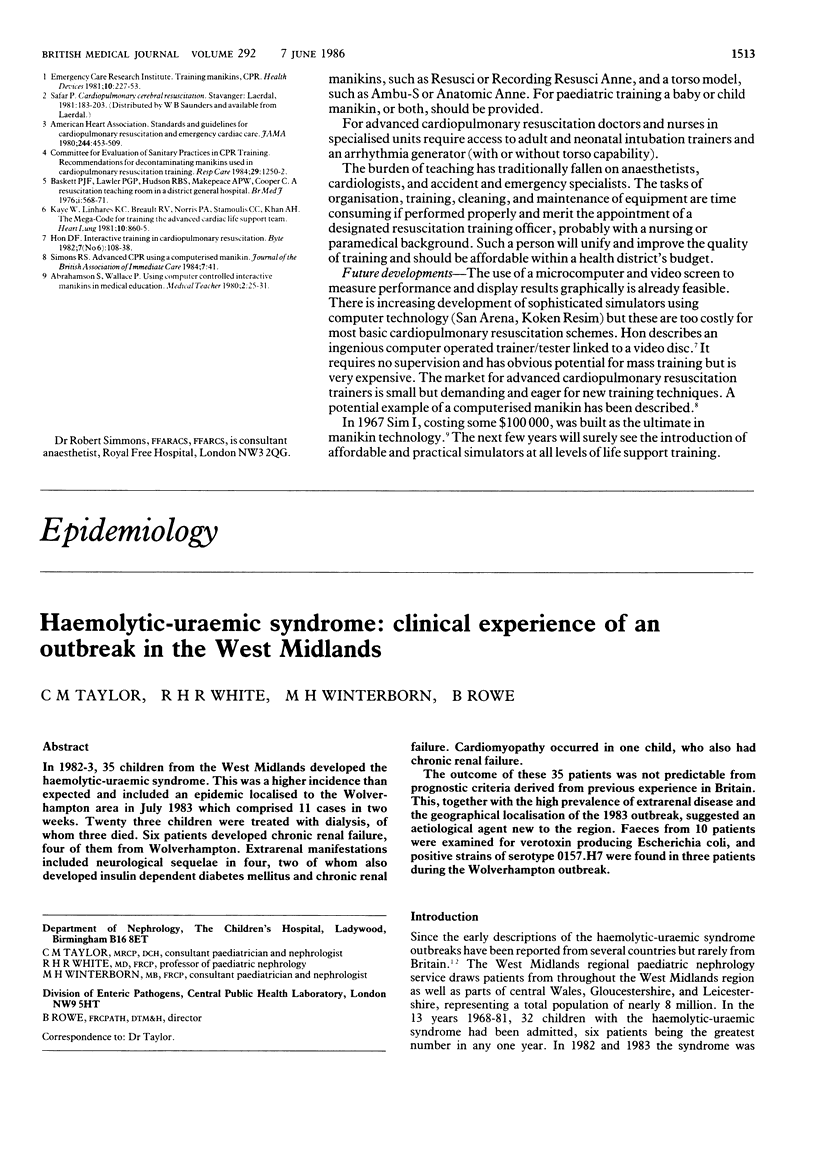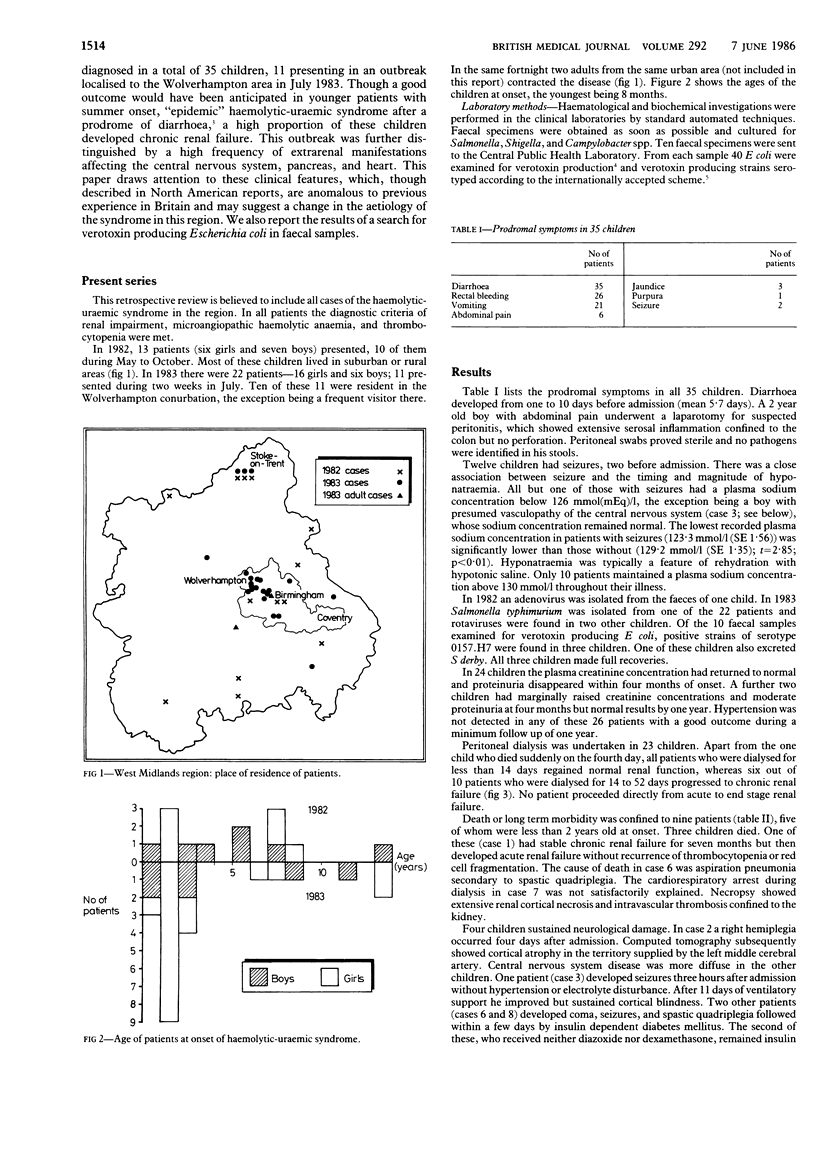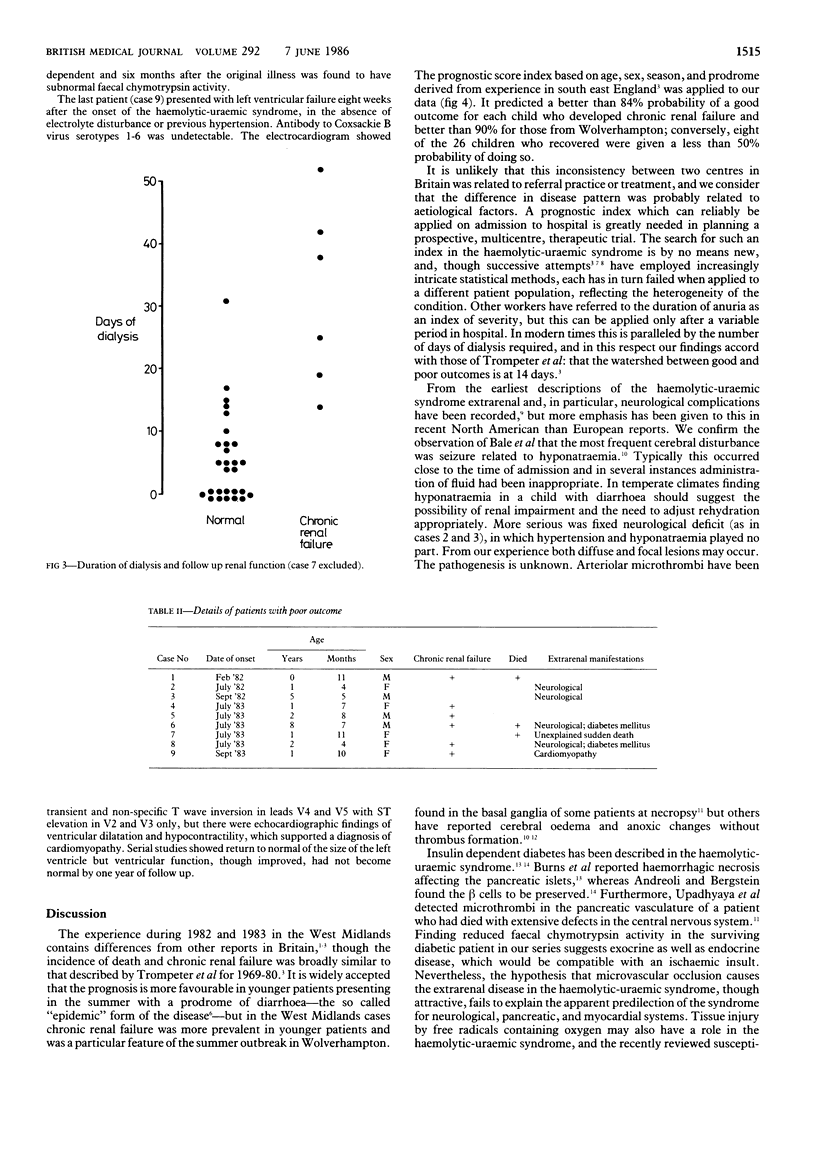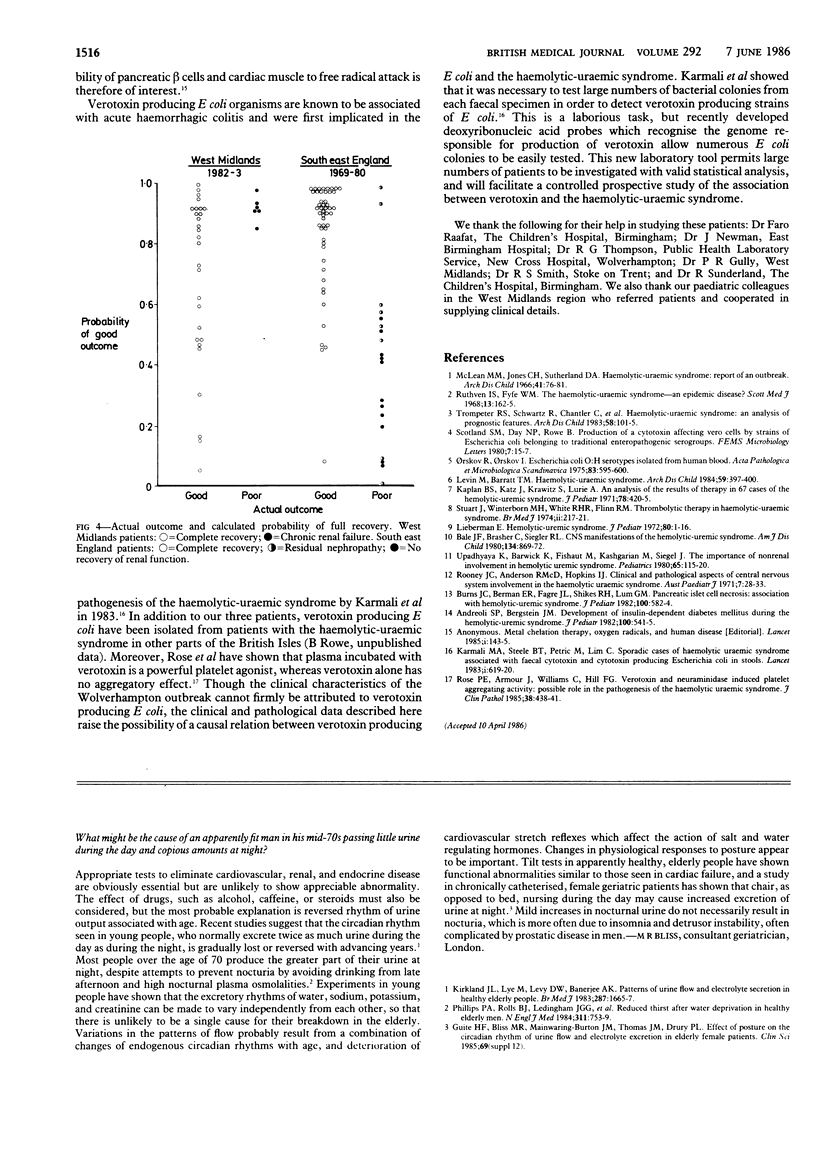Abstract
In 1982-3, 35 children from the West Midlands developed the haemolytic-uraemic syndrome. This was a higher incidence than expected and included an epidemic localised to the Wolverhampton area in July 1983 which comprised 11 cases in two weeks. Twenty three children were treated with dialysis, of whom three died. Six patients developed chronic renal failure, four of them from Wolverhampton. Extrarenal manifestations included neurological sequelae in four, two of whom also developed insulin dependent diabetes mellitus and chronic renal failure. Cardiomyopathy occurred in one child, who also had chronic renal failure. The outcome of these 35 patients was not predictable from prognostic criteria derived from previous experience in Britain. This, together with the high prevalence of extrarenal disease and the geographical localisation of the 1983 outbreak, suggested an aetiological agent new to the region. Faeces from 10 patients were examined for verotoxin producing Escherichia coli, and positive strains of serotype O157.H7 were found in three patients during the Wolverhampton outbreak.
Full text
PDF



Selected References
These references are in PubMed. This may not be the complete list of references from this article.
- Andreoli S. P., Bergstein J. M. Development of insulin-dependent diabetes mellitus during the hemolytic-uremic syndrome. J Pediatr. 1982 Apr;100(4):541–545. doi: 10.1016/s0022-3476(82)80749-x. [DOI] [PubMed] [Google Scholar]
- Bale J. F., Jr, Brasher C., Siegler R. L. CNS manifestations of the hemolytic-uremic syndrome. Relationship to metabolic alterations and prognosis. Am J Dis Child. 1980 Sep;134(9):869–872. doi: 10.1001/archpedi.1980.02130210053014. [DOI] [PubMed] [Google Scholar]
- Burns J. C., Berman E. R., Fagre J. L., Shikes R. H., Lum G. M. Pancreatic islet cell necrosis: association with hemolytic-uremic syndrome. J Pediatr. 1982 Apr;100(4):582–584. doi: 10.1016/s0022-3476(82)80758-0. [DOI] [PubMed] [Google Scholar]
- Kaplan B. S., Katz J., Krawitz S., Lurie A. An analysis of the results of therapy in 67 cases of the hemolytic-uremic syndrome. J Pediatr. 1971 Mar;78(3):420–425. doi: 10.1016/s0022-3476(71)80221-4. [DOI] [PubMed] [Google Scholar]
- Karmali M. A., Steele B. T., Petric M., Lim C. Sporadic cases of haemolytic-uraemic syndrome associated with faecal cytotoxin and cytotoxin-producing Escherichia coli in stools. Lancet. 1983 Mar 19;1(8325):619–620. doi: 10.1016/s0140-6736(83)91795-6. [DOI] [PubMed] [Google Scholar]
- Kirkland J. L., Lye M., Levy D. W., Banerjee A. K. Patterns of urine flow and electrolyte excretion in healthy elderly people. Br Med J (Clin Res Ed) 1983 Dec 3;287(6406):1665–1667. doi: 10.1136/bmj.287.6406.1665. [DOI] [PMC free article] [PubMed] [Google Scholar]
- Levin M., Barratt J. M. Haemolytic uraemic syndrome. Arch Dis Child. 1984 May;59(5):397–400. doi: 10.1136/adc.59.5.397. [DOI] [PMC free article] [PubMed] [Google Scholar]
- Lieberman E. Hemolytic-uremic syndrome. J Pediatr. 1972 Jan;80(1):1–16. doi: 10.1016/s0022-3476(72)80445-1. [DOI] [PubMed] [Google Scholar]
- McLean M. M., Jones C. H., Sutherland D. A. Haemolytic-uraemic syndrome. A report of an outbreak. Arch Dis Child. 1966 Feb;41(215):76–81. doi: 10.1136/adc.41.215.76. [DOI] [PMC free article] [PubMed] [Google Scholar]
- Orskov F., Orskov I. Escherichia coli O:H serotypes isolated from human blood. Prevalence of the K1 antigen with technical details of O and H antigenic determination. Acta Pathol Microbiol Scand Suppl. 1975 Dec;83(6):595–600. [PubMed] [Google Scholar]
- Phillips P. A., Rolls B. J., Ledingham J. G., Forsling M. L., Morton J. J., Crowe M. J., Wollner L. Reduced thirst after water deprivation in healthy elderly men. N Engl J Med. 1984 Sep 20;311(12):753–759. doi: 10.1056/NEJM198409203111202. [DOI] [PubMed] [Google Scholar]
- Rooney J. C., Anderson R. M., Hopkins I. J. Clinical and pathological aspects of central nervous system involvement in the haemolytic uraemic syndrome. Aust Paediatr J. 1971 Mar;7(1):28–33. doi: 10.1111/j.1440-1754.1971.tb02465.x. [DOI] [PubMed] [Google Scholar]
- Rose P. E., Armour J. A., Williams C. E., Hill F. G. Verotoxin and neuraminidase induced platelet aggregating activity in plasma: their possible role in the pathogenesis of the haemolytic uraemic syndrome. J Clin Pathol. 1985 Apr;38(4):438–441. doi: 10.1136/jcp.38.4.438. [DOI] [PMC free article] [PubMed] [Google Scholar]
- Ruthven I. S., Fyfe W. M. The haemolytic uraemic syndrome--an epidemic disease? Scott Med J. 1968 May;13(5):162–165. doi: 10.1177/003693306801300505. [DOI] [PubMed] [Google Scholar]
- Stuart J., Winterborn M. H., White R. H., Flinn R. M. Thrombolytic therapy in haemolytic--uraemic syndrome. Br Med J. 1974 Jul 27;3(5925):217–221. doi: 10.1136/bmj.3.5925.217. [DOI] [PMC free article] [PubMed] [Google Scholar]
- Trompeter R. S., Schwartz R., Chantler C., Dillon M. J., Haycock G. B., Kay R., Barratt T. M. Haemolytic-uraemic syndrome: an analysis of prognostic features. Arch Dis Child. 1983 Feb;58(2):101–105. doi: 10.1136/adc.58.2.101. [DOI] [PMC free article] [PubMed] [Google Scholar]


